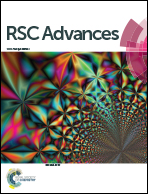Computational study on gold-catalyzed (4 + 3) intramolecular cycloaddition of trienyne: mechanism, reactivity and selectivity†
Abstract
The reaction mechanism, reactivity and selectivity of the Au(I)-catalyzed intramolecular (4 + 3) cycloaddition of trienyne have been studied by density functional theory (DFT) calculations. The reaction mechanism includes the following: the Au(I) species coordinating to the carbon–carbon triple bond of trienyne, the cyclization to form the five-membered ring intermediate, 1,2-OAc (acetoxy) shift with the form of the intermediate fused with the five-membered ring and three-membered ring, and the simultaneous regeneration of the catalyst. After the Cope rearrangement, the (4 + 3) cycloaddition product is formed. The rate-determining intermediate and transition state for the (4 + 3) cycloaddition are the substrate and the transition state for the Cope arrangement. The reactivity of the (4 + 3) cycloaddition is largely affected by both the ligands of the catalyst and substitutions of the substrate. (i) Modifying the ligands of the catalysts and substitution can improve the reactivity of the (4 + 3) cycloaddition by strengthening the donating electron ability of the C–C triple bond to the catalyst and the steric hindrance caused by the bulky ligand in the catalyst. (ii) The selectivity for the trans-(4 + 3) cycloaddition product is mainly caused by the strong steric interaction of the substitutions on the substrate. The present computational results may help people to design an efficient (4 + 3) cycloaddition reaction by controlling the substitution of both catalyst and substrate reactant.


 Please wait while we load your content...
Please wait while we load your content...